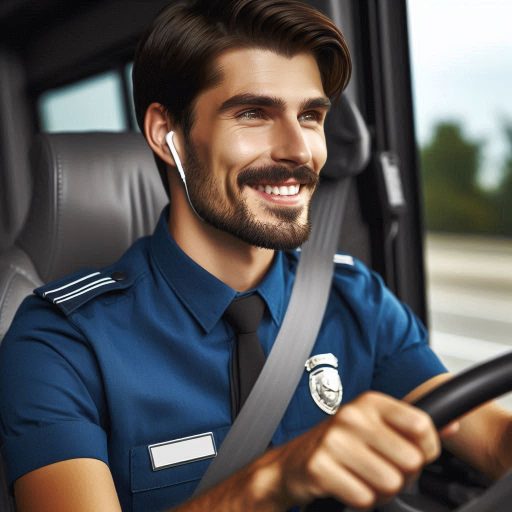Introduction
In this blog post, we will explore Food Delivery Driver Dealing with Bad Weather.
Food delivery drivers often face numerous challenges when delivering during bad weather conditions.
These challenges include navigating slippery roads, dealing with reduced visibility, and ensuring timely delivery to customers.
Adaptability and preparedness are crucial for food delivery drivers to successfully overcome these obstacles.
Being able to adjust their routes and delivery methods based on weather conditions can help them maintain efficiency and customer satisfaction.
Stay informed of weather conditions
Use weather apps to track the weather
As a food delivery driver, staying informed about weather conditions is crucial.
Weather apps can be your best friends on the job.
They provide real-time updates on temperature, precipitation, and wind conditions.
Popular apps like Weather.com or AccuWeather offer accurate forecasts tailored to your location.
Stay updated on any potential storms or severe weather warnings
Check these apps regularly throughout your shift.
Set alerts for severe weather warnings, such as thunderstorms or snowstorms.
This helps you prepare for any sudden changes that might affect your deliveries.
Monitoring weather conditions helps you avoid dangerous situations.
Severe storms can create hazardous driving conditions.
Heavy rain can reduce visibility and make roads slippery.
Snow and ice can lead to accidents and delays.
Staying informed allows you to make smart decisions about when to deliver.
Plan routes accordingly based on weather forecasts
Use your weather updates to plan your routes effectively.
If a storm is approaching, consider completing your deliveries earlier.
Choose routes that minimize your exposure to bad weather.
Transform Your Career Today
Unlock a personalized career strategy that drives real results. Get tailored advice and a roadmap designed just for you.
Start NowAvoid areas prone to flooding or heavy traffic.
When planning your routes, prioritize safety over speed.
Sometimes, it’s better to take a longer, safer route.
Traffic conditions can change rapidly during bad weather.
Be prepared for potential road closures or detours due to flooding or accidents.
In summary, staying informed about weather conditions is vital for food delivery drivers.
Use weather apps to track the forecast and stay updated on storms.
Always plan your routes based on the latest weather information.
By doing so, you enhance your safety and improve your delivery efficiency.
Stay safe out there and keep your deliveries on track!
Read: Legal Rights and Responsibilities of Food Delivery Drivers
Prepare necessary equipment
As a food delivery driver, one of the biggest challenges you might face is dealing with bad weather conditions.
Whether it’s rain, snow, or ice, you need to be prepared to navigate through these obstacles to ensure timely and safe deliveries.
Here are some tips on how to handle bad weather as a food delivery driver:
Invest in proper rain gear
Make sure you have a waterproof jacket, pants, and boots to keep yourself dry while making deliveries in the rain.
Being wet can not only be uncomfortable but also affect your concentration on the road.
Keep an umbrella in the delivery vehicle
Having an umbrella handy can be a lifesaver when unexpected showers hit during your shift.
It will help you stay dry and protect the food from getting wet, ensuring customer satisfaction.
Equip your vehicle with necessary tools
In winter weather, it’s essential to have ice scrapers and snow shovels in your delivery vehicle.
Showcase Your Business Today
Reach thousands of readers actively exploring professional services. Publish your business profile and grow your audience now.
Publish NowClearing snow off your car and ensuring good visibility is crucial for safe driving in snowy conditions.
Check weather forecasts
Stay informed about the weather conditions in your area by checking forecasts regularly.
This will help you plan your routes accordingly and prepare for any potential weather-related challenges.
Drive cautiously
When the roads are slippery or visibility is limited, drive at a reduced speed and increase your following distance to give yourself more time to react to any sudden changes in traffic.
Safety should always be your top priority.
Communicate with customers
If you anticipate delays due to bad weather, communicate proactively with customers to update them on the status of their delivery.
This will help manage their expectations and avoid any misunderstandings.
Stay alert and focused
Bad weather conditions can be distracting, but it’s important to stay focused on the road and your surroundings.
Avoid using your phone or other distractions that could compromise your safety while driving.
Take breaks when needed
If the weather becomes too severe, don’t hesitate to take a break and wait for conditions to improve.
Your safety is paramount, and it’s better to delay deliveries than to risk an accident.
Stay updated on road conditions
Check for road closures, accidents, or other disruptions that could affect your delivery route.
Being aware of any roadblocks will help you plan alternative routes and avoid unnecessary delays.
Adjust your schedule
During bad weather, it’s important to be flexible with your schedule and allow extra time for deliveries.
Factor in potential delays caused by weather conditions and plan your routes accordingly to avoid rushing.
By following these tips and being prepared with the right equipment, you can navigate through bad weather conditions as a food delivery driver safely and efficiently.
Remember that your well-being and the safety of others on the road should always come first, so take the necessary precautions to handle any weather-related challenges that may come your way.
Read: Food Delivery Driver Community: Networking Tips
Drive cautiously
In adverse weather conditions, such as rain or snow, it is crucial for food delivery drivers to adjust their driving habits to ensure safety on the road.
Here are some tips to help delivery drivers navigate through bad weather conditions:
Slow down and increase following distance
When driving in rainy or snowy conditions, it is essential to reduce your speed to maintain control of your vehicle.
Wet or icy roads can significantly reduce traction, so slowing down can help prevent accidents.
Additionally, increasing your following distance gives you more time to react to sudden stops or obstacles on the road.
Avoid sudden stops or sharp turns
In bad weather, sudden stops or sharp turns can cause your vehicle to skid or lose control.
To prevent this, it is best to brake gently and early when approaching a stop sign or traffic light.
When making turns, reduce your speed and take wider turns to maintain traction on slippery roads.
Be extra cautious of wet or icy roads and potential hazards
When driving in rainy or snowy conditions, be on the lookout for potential hazards such as black ice, puddles, or fallen debris.
Black ice can be particularly dangerous as it is difficult to spot and can cause your vehicle to lose traction unexpectedly.
Drive slowly over wet or icy patches and avoid sudden maneuvers to reduce the risk of sliding.
By following these tips and driving cautiously in bad weather, food delivery drivers can ensure their safety and the timely delivery of orders to customers.
Remember, safety should always be the top priority when driving in challenging weather conditions.
Read: Food Delivery Driver Stories: Tales from the Road

Communicate with customers
Communication is key when dealing with bad weather as a food delivery driver.
Keeping customers informed can help manage their expectations and ensure satisfaction.
Here are some important aspects of communication with customers:
Inform customers of potential delays
As soon as you realize that the weather conditions might cause delays in deliveries, make sure to communicate this to your customers.
Send them a message or call them to let them know about the situation.
Being proactive in informing them will help manage their expectations and prevent any misunderstandings.
Offer alternative delivery options
If the weather conditions are particularly severe and you anticipate significant delays, it might be a good idea to offer alternative delivery options to your customers.
For example, you could suggest picking up the order themselves or rescheduling the delivery for a later time when the weather improves.
Showcase Your Business Today
Reach thousands of readers actively exploring professional services. Publish your business profile and grow your audience now.
Publish NowProviding these alternatives shows that you are willing to work with them to find a solution despite the challenges posed by the weather.
Keep customers updated
Throughout the delivery process, it’s important to keep your customers updated on the status of their orders.
If there are any unforeseen delays or changes in the delivery time, make sure to communicate this to them promptly.
Customers appreciate transparency and will be more understanding if they are kept in the loop about any issues that may arise due to bad weather.
In short, effective communication with customers is essential when dealing with bad weather as a food delivery driver.
By informing them of potential delays, offering alternative delivery options, and keeping them updated on the status of their orders, you can help manage their expectations and ensure a positive delivery experience despite the challenges posed by the weather.
Read: Maximizing Efficiency: Food Delivery Driver Hacks
Protect the food
Utilize insulated delivery bags
During bad weather conditions like rain or snow, using insulated delivery bags can make a significant difference in keeping the food warm and protected.
These bags are designed to maintain the temperature of the food, preventing it from getting cold or soggy during transit.
When selecting insulated delivery bags, opt for ones with proper insulation that can retain heat for an extended period.
This will ensure that the food stays at the right temperature until it reaches the customer’s doorstep.
Make sure to invest in high-quality insulated bags that are durable and easy to clean.
This will help you maintain a professional appearance and ensure that the bags last for a long time, even with frequent use in challenging weather conditions.
Additionally, consider having multiple insulated bags of different sizes to accommodate various types of orders.
This will allow you to efficiently deliver both small and large orders while ensuring that all food items are properly insulated and protected.
Secure and water-resistant packaging
Along with using insulated delivery bags, it’s essential to ensure that the food packaging is secure and water-resistant.
This will help prevent any damage to the food due to exposure to moisture or rain during the delivery process.
Use packaging materials that are sturdy and can withstand external elements like rain or snow.
Avoid flimsy containers or bags that may leak or break easily, compromising the quality of the food inside.
Seal the food packaging securely to prevent any spills or leaks during transit.
Double-check the seals to ensure that they are tight and won’t come loose, especially when facing adverse weather conditions that can add extra pressure on the packaging.
Consider using additional protective measures such as plastic wraps or sealable bags for individual food items to provide an extra layer of protection.
This will help maintain the freshness and quality of the food, even in extreme weather conditions.
Quality check before delivery
Prior to delivering the food to customers, always conduct a thorough quality check to ensure that the food meets your standards.
This includes checking for any visible signs of damage, spoilage, or contamination that may have occurred during transportation.
Inspect the food for freshness, aroma, and overall appearance to confirm that it is in perfect condition and ready for consumption.
Discard any items that do not meet your quality criteria to maintain the reputation of your food delivery service.
Pay attention to temperature-sensitive items and make sure they are stored at the correct temperature throughout the delivery process.
Use a food thermometer if necessary to verify that the food is within the safe temperature range before handing it over to the customer.
Keep a checklist of items to inspect before each delivery to ensure that nothing is missed.
This will help you maintain consistency in your food quality and provide customers with a reliable and satisfactory experience every time they order from you.
Stay safe
When the weather takes a turn for the worse, it’s crucial for food delivery drivers to prioritize safety above all else.
By following these tips, you can ensure that you stay safe on the road while making your deliveries.
Prioritize safety over speed
While it may be tempting to rush through your deliveries, especially when the weather is bad, it’s important to remember that safety should always come first.
Take your time and drive cautiously, even if it means your deliveries will take longer to complete.
Avoid risky maneuvers
In challenging weather conditions, it’s best to avoid risky maneuvers like sudden lane changes or speeding through slippery roads.
These shortcuts may seem like time-savers, but they could end up putting yourself and others at risk.
It’s better to arrive safely, even if it takes a bit longer.
Take breaks when needed
Long shifts can be draining, especially when you’re driving in bad weather.
If you start to feel tired or fatigued, don’t hesitate to pull over and take a break.
Showcase Your Business Today
Reach thousands of readers actively exploring professional services. Publish your business profile and grow your audience now.
Publish NowUse this time to rest, refuel, and recharge so you can continue your deliveries safely.
By following these safety tips, food delivery drivers can navigate challenging weather conditions with confidence and ensure that they reach their destinations safely.
Remember, it’s always better to arrive late than to not arrive at all.
Adapt to changing conditions
When bad weather hits, food delivery drivers must be prepared to adapt to changing conditions to ensure successful deliveries.
Be Flexible with Your Schedule
As a food delivery driver, adapting to changing weather conditions is crucial.
Being flexible with your schedule helps you manage unexpected delays.
When severe weather arises, adjust your work hours accordingly.
If conditions worsen, prioritize safety over punctuality.
Customers will appreciate your commitment to their well-being.
Have Backup Plans in Place
Having backup plans is essential.
Always prepare alternative routes to avoid hazards like flooded streets or heavy traffic.
Familiarize yourself with different roads in your delivery area.
Use navigation apps that provide real-time traffic updates.
These tools can help you find the safest, fastest route.
Additionally, consider alternate delivery options.
If the weather is particularly bad, check if restaurants offer contactless pick-up.
You might also coordinate with fellow drivers to share delivery responsibilities.
This collaboration can help everyone stay safe while fulfilling orders.
Adjust Expectations for Delivery Times
Adjust your expectations for delivery times based on weather challenges.
Inform customers about potential delays before they place their orders.
Clear communication can set realistic expectations and reduce frustration.
Let them know that safety comes first during severe weather.
Maintain a positive attitude, even when conditions are tough.
A friendly demeanor can ease customer concerns.
Many people understand that bad weather affects delivery times.
Show empathy, and be honest about any delays.
Finally, remain proactive in monitoring weather forecasts.
Being informed can help you anticipate problems before they arise.
Adaptability is key to thriving as a food delivery driver.
Embrace flexibility, and always prioritize safety for yourself and your customers.
Conclusion
It is crucial for food delivery drivers to be prepared and adaptable in bad weather conditions.
Safety should always be the top priority, and communication with customers is key during challenging situations.
By being proactive and taking necessary precautions, drivers can ensure a smooth delivery experience for both themselves and their customers.
[E-Books for Sale]
The Big Book of 500 High-Paying Jobs in America: Unlock Your Earning Potential
$19.99 • 500 High-Paying Jobs • 330 pages
Explore 500 high-paying jobs in America and learn how to boost your career, earn more, and achieve success!
See All 500 High-Paying Jobs of this E-Book
1001 Professions Without a Degree: High-Paying American Jobs You Can Start Now
$19.99 • 1001 Professions Without a Degree • 174 pages
Discover 1001 high-paying jobs without a degree! Unlock career tips, skills, and success strategies for just $19.99!




